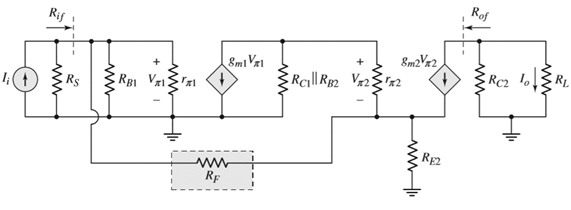
Concept explainers
(a) Using the small-signal equivalent circuit in Figure 12.25 for the circuit in Figure
(a)
To derive: The expression for the small signal current gain of the circuit.
Answer to Problem 12.50P
The value of the small signal current gain is
Explanation of Solution
Given:
The given circuit is shown in Figure 1.

Figure 1
Calculation:
Mark the nodes and redraw the circuit.
The given diagram is shown in Figure 2

Figure 2
By KCL the expression for the current
The expression for the node voltage is given by,
Apply KCL at node
Substitute
The expression for the output current is given by,
Apply KCL at node
Substitute
Substitute
Consider
Thus, the expression for the small signal current gain is,
Conclusion:
Therefore, the value of the small signal current gain is
(b)
The value of the gain
To compare: The obtained value with the given value of gain. and compare it to the value of 9.58.
Answer to Problem 12.50P
The value of the current gain is
Explanation of Solution
Given:
The given circuit is shown below.

The given value of gain is 9.58.
Also, the values are:
Calculation:
The expression to determine the value of the resistance
The expression for the value of the voltage
The expression to determine the value of the current
Substitute
The value of the current
Substitute
The expression to determine the value of the resistance
The value of the Thevenin voltage is given by,
The expression to determine the value of the current
Substitute
The value of the current
Substitute
The expression to determine the transconductance of first transistor is calculated as,
The expression to determine the transconductance of second transistor is calculated as,
The value of the small signal input resistance is calculated as,
The value of the small signal input resistance is calculated as,
The value of A is calculated as,
The value of B is calculated as,
The value of C is calculated as,
The value of D is calculated as,
Substitute
Substitute
The value of the current gain is
Want to see more full solutions like this?
Chapter 12 Solutions
Microelectronics: Circuit Analysis and Design
- Which of these amplifier configuration has a large input impedance, low output impedance and an output voltage that is always less than the input signal? 1. emitter-follower configuration 2. common-base configuration 3. collector feedback configuration 4. voltage-divider bias configurationarrow_forwardIn the circuit given in the figure, Vcc = 15 V, R1 = R2 = 10kΩ, RE = 1KΩ, RL = 0.5kΩ and transistor parameters are given as VBE = 0.7V, ßdc = ß0 = 100. a. Calculate the values of DC bias currents and voltages (IBQ, ICQ and VCEQ). b. Draw the small signal equivalent circuit of the circuit using the hybrid model of the transistor. c. Derive the input impedance expression of the circuit and calculate its value. d. Derive the AVI and AVG voltage gain expressions and calculate their values. e. Derive the current gain expression AI = I0 / Ii and calculate its value. Compare this value you have calculated with the value you will calculate using the expression Aİ = Zi AVI / RL.arrow_forward1) Calculate the DC parameters listed in Table 1 for Q1 and Q2 for the MOSFET amplifier circuit shown in the figure. 2) Calculate the AC parameters. Compute the gain by completing the small signal analysis. Draw the input and output signals to scale.arrow_forward
- The transistor having the characteristics shown in Figure P12.18 is operating with iC=8 mA and vCE = 12 V. Locate the point of operation on both the input and output characteristics.arrow_forwardDC BIAS WITH VOLTAGE FEEDBACK CONFIGURATION QUESTIONS: What happen to the collector voltage, if the emitter resistor is removed and connect the emitter junction to the ground? What happen to the collector current of question number 1? Explain why?arrow_forwardVs=100 mV peak-to-peak, 1 kHz sine signal, Kn=0.4mA/v^2 ,Vt=1V , λ=0.01V^-1 Make the DC analysis of the above given mosfet amplifier circuit. Simulation to tableWrite down the measured values and mathematical calculation results. (The valueswith the units.)DC Parameters ,Measured value ,Calculated ValueVGETCVGSVDVDSIDb. Draw the small signal model for the AC analysis of the circuit. Find the gm, ro, Av values.c. Show the Vs input signal and the Vo output signal of the circuit on the oscilloscope. Volt/div of channels andSpecify time/div values.arrow_forward
- Analog-to-Digital Converters - Block Diagram and Ideal Transfer Curve.arrow_forward(a) Explain the need to use coupling and bypass capacitors in amplifier circuits. (b) Explain how these capacitors affect the biasing and the AC voltage gain of the amplifier stage.arrow_forwardIn the circuit given in the figure, Vcc = 15V, R1 = R2 = 10k ohm, RE = 1k ohm, RL = 0.5k ohm and transistor parameters are given as VBE = 0.7V, beta (dc) = beta (0) = 100. According to this;a) Calculate the values of DC bias currents and voltages (I (BQ), I (CQ), V (CEQ)).b) Using the hybrid model of the transistor, draw the small signal equivalent circuit of the circuit.c) Derive the input impedance expression of the circuit and calculate its value.d) Derive the voltage gain expressions A (vi) and A (VG) and calculate its value.e) Derive the current gain expression A (i) = I (0) / I (i) and calculate its value. I sent you question's image. Thank you..arrow_forward
- What is a typical value of open-loop, low-frequency gain of an op-arop circuit? How does this compare to the ideal value?arrow_forwardFor the feedback amplifier circuit shown below, assuming the internal resistor in each MOSFETs is infinite ( ro = ∞ ) and gm1 = gm2 = gm2 = 2.5mA/V. a) Draw the small AC equivalent circuit of the below amplifier. b) Determine the overall voltage gain.arrow_forwardDraw the AC circuit for basic differential amplifier designarrow_forward
 Power System Analysis and Design (MindTap Course ...Electrical EngineeringISBN:9781305632134Author:J. Duncan Glover, Thomas Overbye, Mulukutla S. SarmaPublisher:Cengage Learning
Power System Analysis and Design (MindTap Course ...Electrical EngineeringISBN:9781305632134Author:J. Duncan Glover, Thomas Overbye, Mulukutla S. SarmaPublisher:Cengage Learning
